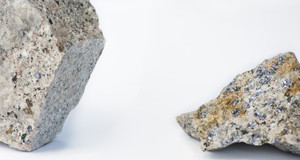
Léo Ramos
Rocks with shiny flecks of molybdenum, along with smaller amounts of copper and other mineralsLéo RamosThe room on the University of São Paulo (USP) campus is filled with boxes of rock fragments, but it is located some 4,000 kilometers from the Amazon forest where they were collected. Geologist Caetano Juliani has made this small space his workplace in the Department of Sedimentary and Environmental Geology at the Geosciences Institute. He picks up a piece of rock with small silvery flecks. “You can touch it. The shiny flecks are molybdenum,” he says, pointing to the element used to make very strong metal alloys, which is in high demand on the international market.
Since 1998, Juliani has been investigating features that few Brazilians associate with the northern part of the country—the volcanoes that once existed in the region known today as Amazonia (see Pesquisa FAPESP Issue nº 174). The festival of eruptions began about two billion years ago in the geologic era known as the Paleoproterozoic, but the consequences have lasted into the present time. Extreme events of different forms of volcanism over the course of millions of years left the region infused with an estimated 1.2 million square kilometers of terrain that holds deposits of gold and several occurrences of copper and molybdenum, carried up from the depths of the Earth to the surface by lava. “That was probably the world’s most extensive occurrence of such intense volcanism,” the geologist notes.
Recently, the USP group has been studying remnants of carbonatite volcanoes, which produce rocks containing minerals such as calcite and dolomite found in the municipality of São Félix do Xingu, state of Pará. The region lies in the southern portion of the Amazonian Craton, an area that has been tectonically stable over the past 800 million years since its formation about three billion years ago. These rarely-occurring volcanoes spewed out magma associated with large deposits of phosphorus, an element used to produce agricultural fertilizers.
According to Juliani, the Amazonian volcanoes were formed by a variety of processes between 2 and 1.87 billion years ago. Until the 1980s, scientists believed that the volcanism in the region had been only of the type typically occurring in stable regions, with few earthquakes or volcanoes—known as anorogenic volcanism. But newly obtained material and additional studies made it clear that these formations were more complex and could be classified as orogenic volcanism, which is characteristic of unstable areas like those found in the Andes, Mexico and the western United States.
The hot water released as magma solidifies produces hydrothermal mineralization, which was the focus of studies by Juliani’s group. These changes in southern Pará are described in a paper published in the Journal of Volcanology and Geothermal Research in April 2016. The mineralization process requires a source to transport the metals closer to the surface, and this role is played by the water vapor that accompanies magma. A deposit of a mineral such as phosphorus or molybdenum can take more than 500,000 years to create. During that time, the metals are carried up to near the Earth’s surface, where they accumulate. But this occurs only if local geological conditions permit. “We don’t know the size of the deposits in Amazonia. What we do know is that the metals were certainly transported and, based on the features mapped, we have strong indications that there were accumulations in the areas between the Tapajós and Xingu rivers,” he says.
On the road
The work in this region is laborious, and researchers face major obstacles accessing certain parts of the forest. The material that must be transported back to the laboratory for analysis consists of pieces of rock. In order to avoid the risk of losing fragments along the way or leaving anything behind at the airport, Juliani says he has often chosen to make the long journey in a pickup truck. The region’s potential for the discovery of ore deposits, which has been reaffirmed by the recent studies, is one motivation, although care must be taken to prevent excessive damage to the forest. “There aren’t enough new discoveries of mineral resources to keep up with production of nearly everything we use nowadays, including electronics. Finding new deposits is essential to society’s continued well-being,” the geologist points out.
“Because of the difficult access, few people are interested in doing this kind of research in the region,” says Carlos Marcello Dias Fernandes, a geologist at the Geosciences Institute of the Federal University of Pará, who is conducting research with Juliani. Fernandes says that no other place in the world has remnants of such ancient, well-preserved volcanic events. “Not all the mapped sites will become mines for economic exploitation, but these studies give us important information on how the Amazon was formed. It’s a question that as yet has few answers,” he says.
Fernandes also draws attention to the collaborative work that geologists have done with Brazilian and foreign mining companies in the region. Scientists help companies find the most probable locations of the deposits, and the companies can begin drilling—a task too costly for researchers to afford on their own. Each meter of rock drilled to collect samples costs over R$2,000, and depths can sometimes reach over 300 meters. In return, however, geologists obtain new and better information about what lies beneath the Earth and was concealed by time, so they can continue their quest and perhaps uncover new mysteries about the ancient Amazonian volcanoes.
Scientific article
CRUZ, R. S. et al. Paleoproterozoic volcanic centers of the São Félix do Xingu region, Amazonian craton, Brazil: Hydrothermal alteration and metallogenetic potential. Journal of Volcanology and Geothermal Research. V. 320, p. 75-87. January 2016.

